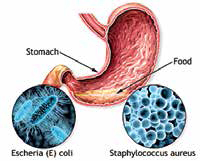Issue No.22 / January 16-31,2016

Food poisoning occurs when you swallow food or water that contains bacteria, parasites, viruses, or the toxins made by these germs. Most cases are caused by common bacteria such as Staphylococcus or E. coli
Food poisoning is defined as any disease of an infectious or toxic nature caused by the consumption of food or drink. The term is most often used to describe the illness, usually diarrhoea and/or vomiting caused by bacteria, viruses or parasites.
Food poisoning can affect a person or a group of people who all ate the same food. It is more common after eating at picnics, school cafeterias, large social functions, or restaurants.
When germs get into the food, it is called contamination. This can happen in different ways:
Your healthcare provider will look for signs of food poisoning. These may include pain in the stomach and signs your body has too little fluid (dehydration).
Your health care provider will look for signs of food poisoning. These may include pain in the stomach and signs your body has too little fluid (dehydration). Tests may be done on your stools or the food you have eaten to find out what type of germ is causing your symptoms
Tests may be done on your stools or the food you have eaten to find out what type of germ is causing your symptoms. However, tests may not always find the cause of the diarrhoea.
In more serious cases, your healthcare provider may order a sigmoidoscopy. This test uses a thin, hollow tube with a light on the end that is placed in the anus to look for the source of bleeding or infection.
Most of the time, you will get better in a couple of days. The goal is to ease symptoms and make sure your body has the proper amount of fluids.
Getting enough fluids and learning what to eat will help keep you comfortable. You may need to:
You can drink oral rehydration mixtures to replace fluids and minerals lost through vomiting and diarrhoea.
Oral rehydration powder can be purchased from a pharmacy. Be sure to mix the powder in safe water.
You can make your own mixture by dissolving ½ teaspoonful each salt and baking soda and 4 tablespoonsful of sugar in 4 ¼ cups (1 litre) water.
If you have diarrhoea and are unable to drink or keep down fluids, you may need fluids given through a vein (by IV). This may be more common in young children.
If you take diuretics, ask your health care provider if you need to stop taking the diuretic while you have diarrhoea. Never stop or change medicines before talking to your doctor.
For the most common causes of food poisoning, your doctor will NOT prescribe antibiotics.
You can buy medicines at the drugstore that help slow diarrhea.
Symptoms from the most common types of food poisoning will often start within 2 - 6 hours of eating the food. That time may be longer or shorter, depending on the cause of the food poisoning.

You can drink oral rehydration mixtures to replace fluids and minerals lost through vomiting and diarrhoea
Most people fully recover from the most common types of food poisoning within 12 - 48 hours. Some types of food poisoning can cause serious complications.
Death from food poisoning in people who are otherwise healthy is rare in the United States.
Dehydration is the most common complication. This can occur from any causes of food poisoning.
Less common, but much more serious complications depend on the bacteria that are causing the food poisoning. These may include: